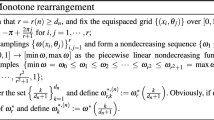Abstract
We present the convergence rates and the explicit error bounds of Hill’s method, which is a numerical method for computing the spectra of ordinary differential operators with periodic coefficients. This method approximates the operator by a finite dimensional matrix. On the assumption that the operator is self-adjoint, it is shown that, under some conditions, we can obtain the convergence rates of eigenvalues with respect to the dimension and the explicit error bounds. Numerical examples demonstrate that we can verify these conditions using Gershgorin’s theorem for some real problems. Main theorems are proved using the Dunford integrals which project an vector to a specific eigenspace.
Similar content being viewed by others
References
Atkinson K.: The numerical solution of the eigenvalue problem for compact integral operators. Trans. Am. Math. Soc. 129, 458–465 (1967)
Atkinson, K., Han, W.: Theoretical Numerical Analysis: A Functional Analysis Framework, 2nd edn. Springer, New York (2005)
Curtis C.W., Deconinck B.: On the convergence of Hill’s method. Math. Comput. 79, 169–187 (2010)
Dunford, N, Schwartz, J.T.: Linear Operators Part II Spectral Theory, Self Adjoint Operators in Hilbert Space. Wiley, New Jersey (1963)
Dunford, N, Schwartz, J.T.: Linear Operators Part III Spectral Operators. Wiley, New Jersey (1971)
Deconinck B., Kutz J.N.: Computing spectra of linear operators using Hill’s method. J. Comput. Phys. 219, 296–321 (2006)
Hill, G.W.: On the part of the motion of the lunar perigee which is a function of the mean motions of the sun and moon. Acta Math. 8, 1–36 (1886)
Hille, E.: Ordinary Differential Equations in the Complex Domain. Dover, New York (1997)
Johnson, M.A., Zumbrun, K. Convergence of Hill’s method for nonselfadjoint operators. SIAM J. Numer. Anal. 50, 64–78 (2012)
Kiper A.: Fourier series coefficients for powers of the Jacobian elliptic functions. Math. Comput. 43, 247–259 (1984)
Krasnosel’skii, M.A., Vainikko, G.M., Zabreiko, P.P., Rutitskii, Ya.B., Stetsenko, V.Ya.: Approximate Solution of Operator Equations. Wolters-Noordhoff, Groningen (1972)
Reed, M., Simon, B.: Methods of modern Mathematical Physics. I. Functional Analysis, revised and enlarged edn. Academic Press, New York (1980)
Reed, M., Simon, B.: Methods of Modern Mathematical Physics. IV. Analysis of Operators. Academic Press, New York (1978)
Vainikko, G.M.: A perturbed Galerkin method and the general theory of approximate methods for nonlinear equations. Zh. Vychisl. Mat. Mat. Fiz. 7, 723–751 (1967) (in Russian) (U.S.S.R. Comput. Math. Math. Phys. 7, 18–32 (1967) (in English))
Varga, R.S.: Gershgorin and His Circles. Springer, Berlin (2004)
Whittaker, E.T., Watson, G.N.: A course of modern analysis, 4th edn. Cambridge University Press, Cambridge (1996) (reprinted)
Author information
Authors and Affiliations
Corresponding author
About this article
Cite this article
Tanaka, K., Murashige, S. Convergence rates and explicit error bounds of Hill’s method for spectra of self-adjoint differential operators. Japan J. Indust. Appl. Math. 31, 25–56 (2014). https://doi.org/10.1007/s13160-013-0125-1
Received:
Revised:
Published:
Issue Date:
DOI: https://doi.org/10.1007/s13160-013-0125-1



